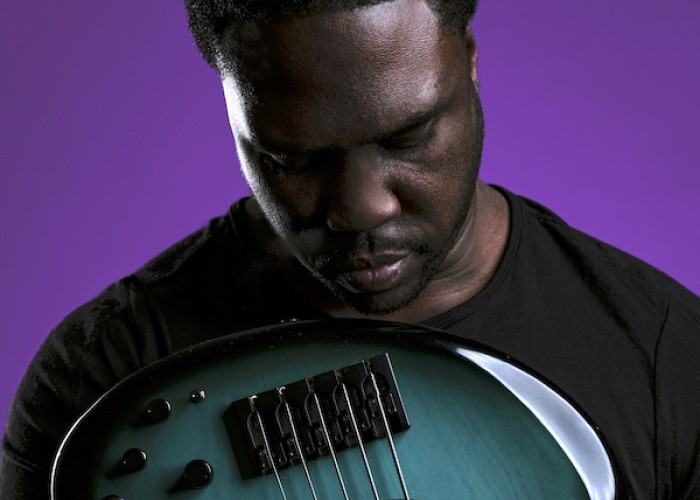Oct 28, 2025 10:47 AM
In Memoriam: Jack DeJohnette, 1942–2025
Jack DeJohnette, a bold and resourceful drummer and NEA Jazz Master who forged a unique vocabulary on the kit over his…

“Color Of Noize is what someone makes of it,” says bassist Derrick Hodge while discussing his new Blue Note release.
(Photo: Ryan Landell)Not long ago, Derrick Hodge had a conversation that forever altered his perspective.
“I had the honor of co-producing Justin Kauflin’s album Coming Home,” Hodge said about the pianist’s 2018 album. “When he first came to me, he said it was because he saw colors when he heard my music. He’s blind, but he saw colors, and that is what drew him to me. ... Suddenly, it could not have been less about what each individual song might have meant to me when I was composing it. For someone else, it meant something that I couldn’t even imagine, and it was absolutely as valid as what I might have been feeling.”
It’s an awareness that every artist comes to sooner or later, but an awareness that generally doesn’t transform how they make art. For Hodge, however, it became an entirely new way of thinking about music. If there was no correct definition of his work, why define it at all? He calls the approach the “color of noize,” which is also the name of Hodge’s new band and his new Blue Note album. If the name seems elusive and indeterminate, that might have been Hodge’s intent.
“What ‘color of noize’ is, officially, is a question mark,” he said. “The more you ask, the more you get no definitive answer. Color Of Noize is what someone makes of it. It’s what the music hopefully means to a person when they hear it—beyond trying to define what it is, what it’s about, what point it’s trying to prove, musically. The point is for people to ask the question, but to come up with their own answers.”
The music, too, refuses to provide easy answers.
Color Of Noize is heavy on atmosphere, with pianist/organist Jahari Stampley, electronic keyboardist Michael Aaberg and turntablist DJ Jahi Sundance blending along with Hodge’s electric bass into hazy washes of sound. But it’s equally heavy on percussion, with dual drummers Mike Mitchell (aka Blaque Dynamite) and Justin Tyson powering nearly every track. Running through the sonic nebulae are recognizable streaks of gospel, funk, hip-hop, r&b, pop and jazz (the last being easiest to discern as the band offers up a cover of Wayne Shorter’s “Fall”).
Hodge, at various points in his career, has been identified with any and all of these genres: His resume includes work with Mulgrew Miller, Terence Blanchard, Jill Scott, Tye Tribbett and Common, among others. Instead of musicians’ frequent urge to resist being put into any of those categories, though, Hodge chooses to be in all of them. That’s also part of the “color of noize” concept.
“Part of that question mark is also the question mark of, ‘Who am I?’” Hodge said. “If people choose to hear me as any one of those things, I’ll take it as an honor that they accept me as an authentic being in whichever tradition that is. But I can’t hold any of it too tight or try too hard to make sure I’m the best version of myself. I wanted to make sure that every part of it was about me letting go and trusting what happens.”
In a sense, that’s another form of resistance: If Hodge belongs to every genre, he belongs to no genre, and anyone who encounters his music will decide what it is for themselves.
Hodge even fogs up the definition of himself as a bassist: At various points on Color Of Noize, he plays upright bass, acoustic guitar, piano, synthesizers and synth bass, and contributes vocals.
The music largely is improvised off Hodge’s basic compositional ideas. Of course, that’s in part due to Hodge’s abiding connection to jazz—but it’s also, in this case, because to compose more fully (as Hodge traditionally has done) would be to provide more definition than he now wants there to be.

Jack DeJohnette boasted a musical resume that was as long as it was fearsome.
Oct 28, 2025 10:47 AM
Jack DeJohnette, a bold and resourceful drummer and NEA Jazz Master who forged a unique vocabulary on the kit over his…

D’Angelo achieved commercial and critical success experimenting with a fusion of jazz, funk, soul, R&B and hip-hop.
Oct 14, 2025 1:47 PM
D’Angelo, a Grammy-winning R&B and neo-soul singer, guitarist and pianist who exerted a profound influence on 21st…

Kandace Springs channeled Shirley Horn’s deliberate phrasing and sublime self-accompaniment during her set at this year’s Pittsburgh International Jazz Festival.
Sep 30, 2025 12:28 PM
Janis Burley, the Pittsburgh International Jazz Festival’s founder and artistic director, did not, as might be…

Jim McNeely’s singular body of work had a profound and lasting influence on many of today’s top jazz composers in the U.S. and in Europe.
Oct 7, 2025 3:40 PM
Pianist Jim McNeely, one of the most distinguished large ensemble jazz composers of his generation, died Sept. 26 at…

Drummond was cherished by generations of mainstream jazz listeners and bandleaders for his authoritative tonal presence, a defining quality of his style most apparent when he played his instrument unamplified.
Nov 4, 2025 11:39 AM
Ray Drummond, a first-call bassist who appeared on hundreds of albums as a sideman for some of the top names in jazz…